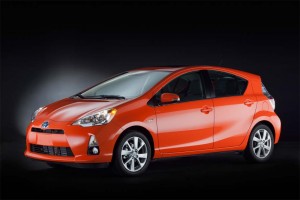
Toyota hopes its expanded Prius line will improve the otherwise dismal loyalty rate among hybrid owners.
Hybrid sales have been surging as fuel prices take their latest run towards record levels. But the news might not be nearly as good as it would seem if a new study by R.L. Polk is any indication.
Despite previous sales surges tied to past petroleum price hikes the U.S. hybrid vehicle market hasn’t been able to maintain its momentum and the Polk study apparently explains why. After living with the high-mileage technology, nearly two of three hybrid owners wind up returning to a more conventional vehicle when it’s next time to trade in.
“Having a hybrid in the product lineup can certainly give a brand a competitive edge when it comes to attracting new customers,” noted Brad Smith, director of Polk’s Loyalty Management Practice. “The repurchase rates of hybrid vehicles are an indication that consumers are continuing to seek alternative solutions to high fuel prices.”
According to Polk tracking data, only 35% of hybrid vehicle owners purchased another gas-electric model when trading in during 2011.
The number varied significantly depending on the hybrid owned. Less than 20% if Honda hybrid owners returned to purchase another gas-electric vehicle – whether from Honda or another brand. For the world’s most-popular hybrid, the Toyota Prius, 41% bought another gas-electric model, whether from Toyota or another brand. But it’s significant that even then, nearly three of every five Prius owners did not go back for another hybrid.
Hybrid loyalty rates have also varied significantly from year to year. During the third quarter of 2011, when fuel prices were reasonably stable, only 30.9% of owners traded in on another hybrid. But when fuel prices started to surge during the final three months of last year, the loyalty rate rose to 40.1%.
Polk officials suggested the technology is having a hard time because of the high cost for hybrids. Analysts note it can take as long as seven to 10 years to recover the added cost through savings on fuel. The industry is struggling to lower that so-called “payback period,” but gains haven’t come quite as quickly as forecast.
There are other factors that limit loyalty. For one thing, there are a growing number of alternatives, including diesels – which are being offered in growing numbers – and advanced versions of conventional gasoline technology. The 2013 Nissan Altima, for example, is expected to deliver 38 mpg on the highway, Ford’s next-generation Fusion close behind at 37 – both yielding only slightly less than the current Camry Hybrid. Hyundai, meanwhile, boasts five different models now getting over 40 mpg on the highway.
Toyota hopes to boost loyalty rates with its expanded Prius “family,” which now includes the smaller Prius C and big Prius V – those being joined later this year by the Prius Plug-in.
But despite continued optimism by hybrid proponents, the technology has shown little forward momentum.
Demand for the technology – especially the dedicated Toyota hybrid line has traditionally soared and then sunk along with fuel prices, and last month saw a huge surge in Prius sales. Whether that trend will hold when pump prices peak remains to be seen. On an annual basis, it peaked at 2.9% in 2008 – the year gas hit its all-time record. Hybrid sales slipped to 2.4% of the U.S. market in 2011.
“The lineup of alternate-drive vehicles and their premium price points just aren’t appealing enough to consumers to give the segment the momentum it once anticipated, especially given the growing strength of fuel economy among compact and midsize competitors,” according to Lacey Plache, Edmunds.com chief economist.
